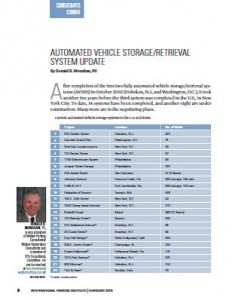After completion of the first two fully automated vehicle storage/retrieval systems (AVSRS) in October 2002 (Hoboken, N.J., and Washington, D.C.), it took another five years before the third system was completed in the U.S., in New York City. To date, 14 systems have been completed, and another eight are under construction. Many more are in the negotiating phase.
Current Automated Vehicle Storage Systems in the U.S. as follows: (see image in link)
So what have we learned about these systems during the past 12 years?
The construction cost is competitive with conventional, ramp-access, self-park garages, particularly when they are constructed underground, under a building, or on a site too small for a conventional garage. The same number of stalls can be constructed in an automated garage at half the volume of a conventional garage. The savings in construction costs can then offset the cost of the automated parking machinery. The construction cost just for the automated parking machinery (not the building shell space) is in the range of $15,000 to $20,000 per space for automated garages of up to 500 stalls and four to five levels. Smaller capacity garages and very tall garages can be up to $30,000 per space.
The operating cost is approximately $55 to $75 per month per space, or approximately double the operating cost of a conventional garage. Maintenance is approximately half of the operating cost and ranges from $35 to $45 per month per space. Garages smaller than 100 spaces are at the high end of those ranges, while larger garages are at the low end.
Design Challenges
One of the biggest design challenges is to configure the correct number of entry/exit compartments for the peak hour arrival/departure traffic volume. One entry/exit compartment has an average service rate of approximately 30 vehicles per hour, although the inbound service rate may be somewhat slower and the outbound service rate somewhat faster. The aggregate volume-to-capacity ratio should not exceed 0.7 to minimize queuing. For example, the peak-hour volume for an office use may be on the order of 40 percent of the capacity for a 500-car garage. The peak-hour volume is then 200 vehicles per hour (the entry/exit compartment can serve both inbound and outbound traffic). The design volume is then 200/0.7 equals 286 vph. The required number of transfer compartments is then 9.5, rounded to 10.
Configuring that many entry/exit compartments at the street level can be a challenge. Therefore, AVSRS garages are more feasible for lower peak-hour traffic volumes than for hotel/residential uses or for small urban infill sites (i.e., less than 100 by 100 feet), where automated parking is the only option that can provide parking under the building.
Another design challenge is to configure the number of transport devices and lifts in the storage compartment to store or deliver a vehicle within two to three minutes. This design is typically left for the manufacturer to determine, while performance testing is provided at commissioning the garage to ensure compliance.
Automated vehicle storage/retrieval systems have come a long way in recent years and are another viable tool to help meet owners’ parking needs.
Donald R. Monahan, PE, is vice president of Walker Parking Consultants/Walker Restoration Consultants and a member of IPI’s Consultants Committee.. He can be reached at don.monahan@walkerparking.com or 303.694.6622.
TPP-2015-02-Automated Vehicle Storage Retrieval System Update

